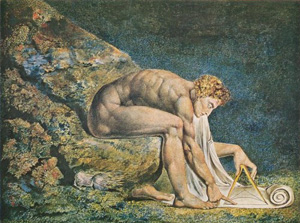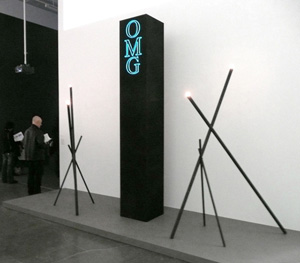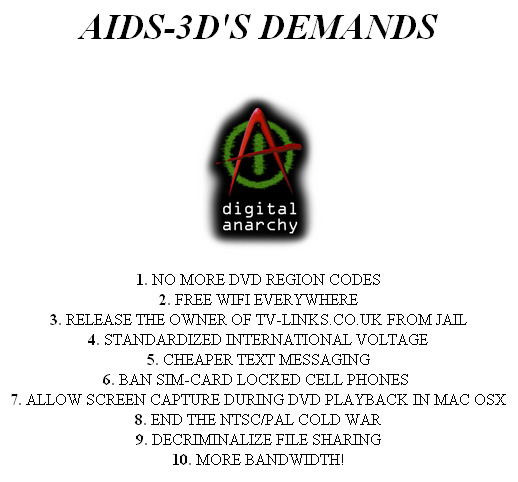https://hyperallergic.com/481/aids-3d-interview/
Click to read
Art / Interviews
Information, Aesthetics & Fun: An Interview with AIDS-3D
Artie Vierkant October 27, 2009
AIDS-3D are artists Daniel Keller and Nik Kosmas. Their work deals with a multitude of issues at the intersection of art, technology and society and they frequently employ cultural ephemera from the Internet rendered in aestheticized and irreverent ways. Their work has been exhibited at The New Museum, PPOW, The X Initiative, Gentili Apri Berlin, Centro de Arte Dos de Mayo, X Biennial de Lyon, and online. They recently contributed an essay, “Hubris/Nemesis/Whatever” to Art Fag City‘s IMG MGMT series.
AIDS-3D also took part in a second, alternative interview which is available on Hyperallergic LABS.
Artie Vierkant: Thanks for agreeing to the interview. First of all, could you guys tell me a little bit about the performance you just did in Spain?
AIDS-3D: Sure no problem. It’s yet to be officially titled but its either “Será” or “Tiempo Reál.” It was a sort of cyber oracle performance. We got a really great Spanish actress who acted as a medium, I can send you a short video hold on–
We had a feed from twitterfall.com on a teleprompter of all tweets that contained the word será without ‘a’? So in other words, all declarative statements about the future. Most were extremely banal.
AV: Naturally.
AIDS-3D: We had the audio connected to Skype which was sent to another computer which was connected to the audio system which created a delay as the information traveled through the net. And then we had the live feed on Ustream which was projected behind her, also creating a sorta infinity effect. And we had a lot of divination incense surrounding her in metal bowls.
AV: Were there any unexpected moments in the feed or did it end up a sort of dry catalogue?
AIDS-3D: We actually aren’t so sure because it was all in Spanish, which we don’t understand. The audience laughed a few times though.
AV: It sounds interesting, it seems to bridge two relatively common tropes in media art — cataloguing a large quantity of related information and a theme from the opposite spectrum, people like Jimmy Joe Roche &c. who use digital technology to create spiritual/spiritualized experiences
AIDS-3D: Yes, but I guess our message is that spiritual experiences are not in any opposition to media or technology, and often technological developments are initiated by spirituality.
AV: Or religion itself — the clocktower, created by the church initially to regulate working schedules for instance. Though now I guess it’s largely being mediated by technology — televangelism, for instance.
AIDS-3D: For sure. The first computer was used to calculate when Easter was.

William Blake, “Newton” (1795)
AV: So this sort of brings me to another point I wanted to raise, which is to what degree does your art engage with research? It seems like a number of your examples in your recent IMG MGMT essay (William Blake’s “Newton,” Ruth Schwartz Cowan, &c.) are derived from the field of the history and sociology of science. Perhaps I’m asking for how much things like this inform your work, or whether they simply inform AIDS-3D’s general philosophy.
AIDS-3D: Well we are researching stuff all the time on the internet. I think that our work has gotten more research based in the past year. We were really reacting against our experiences in academia and maybe feeling a little bit too apathetic towards art theory.
AV: You mean in the IMG MGMT piece or in general?
AIDS-3D: In general, but this reaction has faded a lot, and we are trying to be more directly communicative about ideas that we think are interesting and important. So that is why our work deals a lot with things that seem to be missing in a lot of usual art-dialogue. The IMG MGMT essay was the first time we’ve tried to communicate them in a semi-traditional essay form. And it felt really good, although I don’t think it’s the culmination.

AIDS-3D, “OMG Obelisk” (2007) installated at the Younger Than Jesus show (via Artnet)
AV: Yeah, and if “Será/Tiempo Reál” is any indication then you’re succeeding in a shift for the work — this performance seems quite at a distance from, say, the “OMG Obelisk” (2007) or even the first issue of Free Internet.
AIDS-3D: I do think that the themes are pretty much consistent, but we are little bit less concerned with being entertaining. I do still like using the language of entertainment or spectacle to communicate serious ideas. Artists are never going to be able to communicate something as clearly and rationally as a scientist or a theorist, it’s our role to combine information with aesthetics and fun.
AV: I couldn’t agree more. So speaking of Free Internet, and since we were just on the dreaded “What is art? / What is the role of the artist?” topic, can you talk a little bit about how you approach criticism in your practice? You seem interested in curation, between Free Internet and the AFK Sculpture Park, and I was wondering how you approached these things — how they’re related, how they’re different, as far as the goals you had in mind for them and the type of work they highlight.
AIDS-3D: Maybe it goes without saying, but there is a huge overlap in curatorial and art-making processes, so we sort of take the artist/curator combination for granted. Our site has always been on this edge, functioning as a sort of cybernetic feedback loop with the web: collections and samples and remixes and compilations. We don’t really consider this a radical approach though, it wasn’t a specific decision.
We do plan a second issue of Free Internet, which will be themed on the Omega Point. We plan on having more texts but we aren’t sure if we will end up having an open call for submissions in this issue. But anyone can feel free to send us work for consideration (hope@aids-3d.com)
The consistent element will be the format: .pdf, and the presentation as a limited edition multiple/USB sculpture. We have not shown them this way yet, but we plan to in the coming months. Eventually we plan to have more multimedia pack/USB sculptures available, maybe or maybe not contained to the Free Internet brand identity … and we always plan to have it available to download for free. The sculpture editions will be reasonably priced, but of course usable as a hard drive as well. This is the general direction our work is heading. We want to make more hybrid objects we’re calling “active sculptures.” Basically they’re high-end case mods with a specific conceptual purpose. The major works in this genre that we’re planning are a series of monuments/sculptures with servers inside, running distributed computing programs like seti@home or folding@home. http://distributedcomputing.info/

via http://www.aids-3d.com/demands.html (click to enlarge)
AV: Sounds like an interesting way of solving the commerce-object question while still dealing with intangible media. Are you inspired by or do you know of any other works in this genre? The closest I can think of is James Hoff/Danny Snelson’s “Endless Nameless” (2008-2009), where they assembled a group of uniquely-curated hard drives and sell them for $0.99 a gigabyte; they weren’t aestheticized objects though.
AIDS-3D: Yeah, thats what we’re attempting to address at least. I hadn’t seen their project before, but I had seen a few USB-magazine projects and things of the ilk. All of them seemed to lack a very interesting form. For me its too efficient to just package media on a readymade drive and distribute it. Digital media is often thought of as completely intangible, sorta a perfect symbol of dematerialization of art. But every letter you type has a corresponding physical weight, it’s still “real.” Computers and hard drives might be dense but they are still objects with surfaces which can be celebrated and ornamented. I heard this sorta ridiculous fact the other day that all of the traffic on the Internet at any given time has a physical weight of less than a single grain of sand. It’s nice and poetic but it completely overlooks the massive weight and energy that goes into maintaining the infinitesimal data flow.
AV: Do this and “Será/Tiempo Reál” suggest an increased interest in structuring or drawing information from an amorphous public?
AIDS-3D: Yeah I like that the distributed computing sculptures all act in unison to solve problems, but still have a unique form that highlights their physical presence — and of course, gives them a preciousness that outlasts the diminishing value of their working parts.
I think we’ve always been interested in feedback loops with the web and translation between virtual and material, but the latest performance was the first time we tried to really make this explicit.
AV: Are your sculptures then going to be entering (at least theoretically or mimetically) a notion of the “Web of Things?” Or maybe, what do you think of that vision of the future?

AIDS-3D, “No Fear” (date unknown)
AIDS-3D: Well I don’t think we’re necessarily going to have RFID tags on all of our socks and bananas, but yes we’re heading in that direction. I think that the distinction between objects and information will continue to blur as home 3D printing and manufacturing gets better and better.
AV: I noticed you have a solo show upcoming in November at Gentili Apri; can you share, or are you at liberty to discuss, what you’ll be exhibiting?
AIDS-3D: Actually that show has been rescheduled for February. We’ll also be having a solo show in Stockholm with Niklas Belenius around the same time. It’s too early to say for sure what will be included but there will definitely be some iterations of the active sculpture idea, and some other works that maybe emphasize an inability to make value judgments when given so much access to different sorta of information, and the potentially dangerous (or maybe not) threat of amateurism — i.e. “knowledge enabled mass destruction” that could come from nanotechnology and biotechnology or bedroom nuclear bombs or whatever.
AV: Do you really have a concern over both attention spans in the age of a web with a bounty of information aggregation/sorting tools and the threat of this information to be used meaningfully (detrimental or not)? Do you think these are contradictory concerns or does this, like the semantically “dematerialized material” of the internet and internet art, point to an internal contradiction, or maybe an internal ambivalence, in the way we use/view this technology?
AIDS-3D: I don’t think its an apocalyptic problem, but it makes me stressed out sometimes. I feel like the only way we can adapt to having access to so much information is if we also develop radical-life-extension so that we have long enough lives to do anything with all of the detritus that’s available. As it is now, it’s definitely still uncomfortable, but I expect that this is only a short-term growing pain and not a permanent effect.
Tagged: Hypermedia Interviews
Information, Aesthetics & Fun: An Interview with AIDS-3D
Artie Vierkant October 27, 2009
AIDS-3D are artists Daniel Keller and Nik Kosmas. Their work deals with a multitude of issues at the intersection of art, technology and society and they frequently employ cultural ephemera from the Internet rendered in aestheticized and irreverent ways. Their work has been exhibited at The New Museum, PPOW, The X Initiative, Gentili Apri Berlin, Centro de Arte Dos de Mayo, X Biennial de Lyon, and online. They recently contributed an essay, “Hubris/Nemesis/Whatever” to Art Fag City‘s IMG MGMT series.
AIDS-3D also took part in a second, alternative interview which is available on Hyperallergic LABS.
Artie Vierkant: Thanks for agreeing to the interview. First of all, could you guys tell me a little bit about the performance you just did in Spain?
AIDS-3D: Sure no problem. It’s yet to be officially titled but its either “Será” or “Tiempo Reál.” It was a sort of cyber oracle performance. We got a really great Spanish actress who acted as a medium, I can send you a short video hold on–
We had a feed from twitterfall.com on a teleprompter of all tweets that contained the word será without ‘a’? So in other words, all declarative statements about the future. Most were extremely banal.
AV: Naturally.
AIDS-3D: We had the audio connected to Skype which was sent to another computer which was connected to the audio system which created a delay as the information traveled through the net. And then we had the live feed on Ustream which was projected behind her, also creating a sorta infinity effect. And we had a lot of divination incense surrounding her in metal bowls.
AV: Were there any unexpected moments in the feed or did it end up a sort of dry catalogue?
AIDS-3D: We actually aren’t so sure because it was all in Spanish, which we don’t understand. The audience laughed a few times though.
AV: It sounds interesting, it seems to bridge two relatively common tropes in media art — cataloguing a large quantity of related information and a theme from the opposite spectrum, people like Jimmy Joe Roche &c. who use digital technology to create spiritual/spiritualized experiences
AIDS-3D: Yes, but I guess our message is that spiritual experiences are not in any opposition to media or technology, and often technological developments are initiated by spirituality.
AV: Or religion itself — the clocktower, created by the church initially to regulate working schedules for instance. Though now I guess it’s largely being mediated by technology — televangelism, for instance.
AIDS-3D: For sure. The first computer was used to calculate when Easter was.

William Blake, “Newton” (1795)
AV: So this sort of brings me to another point I wanted to raise, which is to what degree does your art engage with research? It seems like a number of your examples in your recent IMG MGMT essay (William Blake’s “Newton,” Ruth Schwartz Cowan, &c.) are derived from the field of the history and sociology of science. Perhaps I’m asking for how much things like this inform your work, or whether they simply inform AIDS-3D’s general philosophy.
AIDS-3D: Well we are researching stuff all the time on the internet. I think that our work has gotten more research based in the past year. We were really reacting against our experiences in academia and maybe feeling a little bit too apathetic towards art theory.
AV: You mean in the IMG MGMT piece or in general?
AIDS-3D: In general, but this reaction has faded a lot, and we are trying to be more directly communicative about ideas that we think are interesting and important. So that is why our work deals a lot with things that seem to be missing in a lot of usual art-dialogue. The IMG MGMT essay was the first time we’ve tried to communicate them in a semi-traditional essay form. And it felt really good, although I don’t think it’s the culmination.

AIDS-3D, “OMG Obelisk” (2007) installated at the Younger Than Jesus show (via Artnet)
AV: Yeah, and if “Será/Tiempo Reál” is any indication then you’re succeeding in a shift for the work — this performance seems quite at a distance from, say, the “OMG Obelisk” (2007) or even the first issue of Free Internet.
AIDS-3D: I do think that the themes are pretty much consistent, but we are little bit less concerned with being entertaining. I do still like using the language of entertainment or spectacle to communicate serious ideas. Artists are never going to be able to communicate something as clearly and rationally as a scientist or a theorist, it’s our role to combine information with aesthetics and fun.
AV: I couldn’t agree more. So speaking of Free Internet, and since we were just on the dreaded “What is art? / What is the role of the artist?” topic, can you talk a little bit about how you approach criticism in your practice? You seem interested in curation, between Free Internet and the AFK Sculpture Park, and I was wondering how you approached these things — how they’re related, how they’re different, as far as the goals you had in mind for them and the type of work they highlight.
AIDS-3D: Maybe it goes without saying, but there is a huge overlap in curatorial and art-making processes, so we sort of take the artist/curator combination for granted. Our site has always been on this edge, functioning as a sort of cybernetic feedback loop with the web: collections and samples and remixes and compilations. We don’t really consider this a radical approach though, it wasn’t a specific decision.
We do plan a second issue of Free Internet, which will be themed on the Omega Point. We plan on having more texts but we aren’t sure if we will end up having an open call for submissions in this issue. But anyone can feel free to send us work for consideration (hope@aids-3d.com)
The consistent element will be the format: .pdf, and the presentation as a limited edition multiple/USB sculpture. We have not shown them this way yet, but we plan to in the coming months. Eventually we plan to have more multimedia pack/USB sculptures available, maybe or maybe not contained to the Free Internet brand identity … and we always plan to have it available to download for free. The sculpture editions will be reasonably priced, but of course usable as a hard drive as well. This is the general direction our work is heading. We want to make more hybrid objects we’re calling “active sculptures.” Basically they’re high-end case mods with a specific conceptual purpose. The major works in this genre that we’re planning are a series of monuments/sculptures with servers inside, running distributed computing programs like seti@home or folding@home. http://distributedcomputing.info/

via http://www.aids-3d.com/demands.html (click to enlarge)
AV: Sounds like an interesting way of solving the commerce-object question while still dealing with intangible media. Are you inspired by or do you know of any other works in this genre? The closest I can think of is James Hoff/Danny Snelson’s “Endless Nameless” (2008-2009), where they assembled a group of uniquely-curated hard drives and sell them for $0.99 a gigabyte; they weren’t aestheticized objects though.
AIDS-3D: Yeah, thats what we’re attempting to address at least. I hadn’t seen their project before, but I had seen a few USB-magazine projects and things of the ilk. All of them seemed to lack a very interesting form. For me its too efficient to just package media on a readymade drive and distribute it. Digital media is often thought of as completely intangible, sorta a perfect symbol of dematerialization of art. But every letter you type has a corresponding physical weight, it’s still “real.” Computers and hard drives might be dense but they are still objects with surfaces which can be celebrated and ornamented. I heard this sorta ridiculous fact the other day that all of the traffic on the Internet at any given time has a physical weight of less than a single grain of sand. It’s nice and poetic but it completely overlooks the massive weight and energy that goes into maintaining the infinitesimal data flow.
AV: Do this and “Será/Tiempo Reál” suggest an increased interest in structuring or drawing information from an amorphous public?
AIDS-3D: Yeah I like that the distributed computing sculptures all act in unison to solve problems, but still have a unique form that highlights their physical presence — and of course, gives them a preciousness that outlasts the diminishing value of their working parts.
I think we’ve always been interested in feedback loops with the web and translation between virtual and material, but the latest performance was the first time we tried to really make this explicit.
AV: Are your sculptures then going to be entering (at least theoretically or mimetically) a notion of the “Web of Things?” Or maybe, what do you think of that vision of the future?

AIDS-3D, “No Fear” (date unknown)
AIDS-3D: Well I don’t think we’re necessarily going to have RFID tags on all of our socks and bananas, but yes we’re heading in that direction. I think that the distinction between objects and information will continue to blur as home 3D printing and manufacturing gets better and better.
AV: I noticed you have a solo show upcoming in November at Gentili Apri; can you share, or are you at liberty to discuss, what you’ll be exhibiting?
AIDS-3D: Actually that show has been rescheduled for February. We’ll also be having a solo show in Stockholm with Niklas Belenius around the same time. It’s too early to say for sure what will be included but there will definitely be some iterations of the active sculpture idea, and some other works that maybe emphasize an inability to make value judgments when given so much access to different sorta of information, and the potentially dangerous (or maybe not) threat of amateurism — i.e. “knowledge enabled mass destruction” that could come from nanotechnology and biotechnology or bedroom nuclear bombs or whatever.
AV: Do you really have a concern over both attention spans in the age of a web with a bounty of information aggregation/sorting tools and the threat of this information to be used meaningfully (detrimental or not)? Do you think these are contradictory concerns or does this, like the semantically “dematerialized material” of the internet and internet art, point to an internal contradiction, or maybe an internal ambivalence, in the way we use/view this technology?
AIDS-3D: I don’t think its an apocalyptic problem, but it makes me stressed out sometimes. I feel like the only way we can adapt to having access to so much information is if we also develop radical-life-extension so that we have long enough lives to do anything with all of the detritus that’s available. As it is now, it’s definitely still uncomfortable, but I expect that this is only a short-term growing pain and not a permanent effect.
Tagged: Hypermedia Interviews
